Content
- What is vitiligo and why does it occur?
- Why is vitiligo dangerous?
- Can Vitiligo Be Cured?
- The effectiveness of different regimens and methods of treatment, advantages and disadvantages
- Systemic therapy
- Local therapy with ointments
- Phytotherapy
- Vitamin therapy
- Phototherapy
- UV lamp treatment
- Laser therapy
- Surgery
- The most effective methods for the treatment of different forms of vitiligo, according to the reviews of the cured
- Acrofacial
- Universal
- Focal (focal)
- Segmental
- Vitiligo of the mucous membranes
- Dotted vitiligo (confetti spots)
- Polychrome
- Inflammatory
- Perinevus
- Vitiligo treatment video
Vitiligo is a chronic skin disease, which occurs in adults and children of different age groups. Treatment of this disease requires compliance with an integrated therapeutic approach using medications, physiotherapy methods, the use of folk recipes for cleansing epithelial tissues. Reviews of people who have recovered from vitiligo confirm the complexity and duration of the treatment that must be completed in order to completely get rid of this ailment.
What is vitiligo and why does it occur?
Vitiligo is a dermatological disease that occurs due to a violation of the physiological pigmentation of the skin. The disease is difficult to treat with medication. In some areas of epithelial tissues, the melanin pigment, which is responsible for giving the skin a natural flesh-colored or brown tint, disappears. Vitiligo develops gradually, and is also characterized by a slow progression of the pathological process.
According to the reviews of the cured, this disease is characterized by the following symptoms:
- on the body, white areas of skin of different shapes and localization are formed (clinical studies show that in in these foci of epithelial tissues, there are practically no melanocytes responsible for a stable level of melanin);
- as the disease develops, age spots expand their boundaries;
- depigmented lesions cover the back, abdomen, hands, feet of the lower extremities;
- age spots do not cause pain, itching or discomfort is completely absent.
Vitiligo is most commonly diagnosed in young people between the ages of 10 and 30. Doctors-dermatologists and scientists do not have a consensus about the nature of the origin of this disease.
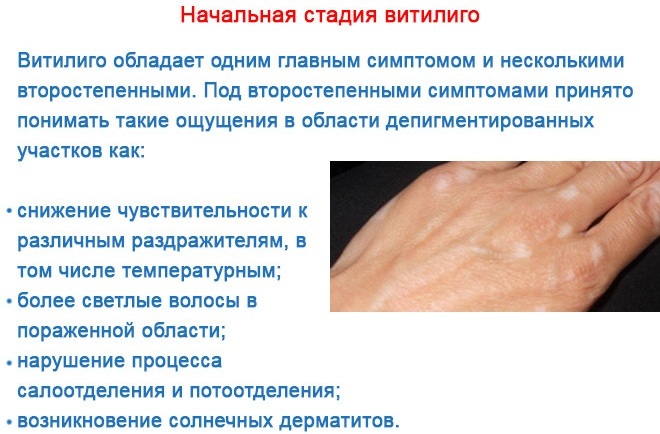
There are theories that sudden depigmentation of certain areas of the skin occurs under the influence of the following factors:
- concomitant neuroendocrine diseases of the body;
- autoimmune disorders;
- the consequences of chemical intoxication;
- complications of inflammatory skin diseases;
- long-term therapy with potent drugs;
- hereditary predisposition.
According to international statistics, about 1% of people diagnosed with vitiligo live in the world. Working with harmful substances, stressful situations, hormonal disorders and inflammatory diseases of internal organs increase the risk of depigmented skin areas.
Why is vitiligo dangerous?
Treatment of vitiligo (reviews of those who have been cured contain information about the effectiveness of the methods) is a complex and lengthy process that can last for several years.
The main danger of this disease is that the skin, deprived of the melanin pigment, remains vulnerable to exposure to ultraviolet radiation.
The depigmented areas of epithelial tissues are burned even after a short contact with the direct rays of the sun. A characteristic redness and blisters filled with fluid appear on the patient's body.
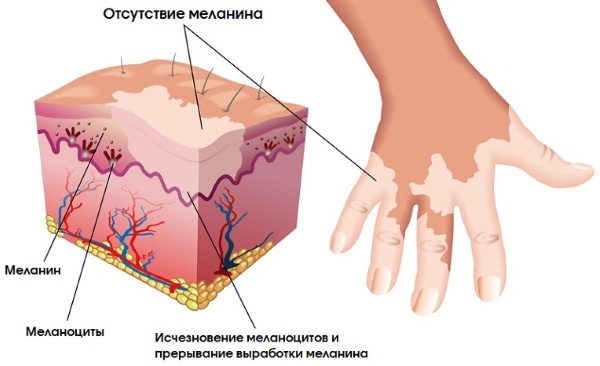
The rest of the vitiligo is not harmful to human health. This disease does not contribute to the development of skin cancer, psoriasis or any other severe dermatological pathologies. Vitiligo causes cosmetic defects in certain parts of the body, becomes the cause of psychological complexes, low self-esteem, and self-doubt.
The presence of this disease is especially difficult for adolescent children and young people 20-30 years old. Depigmented spots of unclear etiology can cover the entire surface of the upper extremities, spread to the neck, back, décolleté, face. Vitiligo is not contagious, does not threaten the patient's health, but significantly reduces his quality of life.
Can Vitiligo Be Cured?
Currently, there are a large number of different methods for the treatment of vitiligo, but there is no generally accepted protocol for the treatment of this disease. A prerequisite for the complete disposal of depigmented areas of the body is the elimination of pathological factors that provoke dermatological symptoms.
In medical practice, there are occasional cases when the foci of vitiligo disappeared on their own without the use of folk and drug therapy. A complete cure for this ailment is possible, but the re-development of depigmentation against the background of a relapse of the disease is not excluded.
The effectiveness of different regimens and methods of treatment, advantages and disadvantages
Treatment of vitiligo (reviews of those who have been cured confirm the fact of a gradual growth of discolored areas of the body) provides for a course of taking medications based on antioxidants, immunomodulators, normalizing functions the immune system.  To stimulate the formation of new melanocyte cells, the method of ultraviolet irradiation of the skin is used. Each direction in the treatment of vitiligo has its own advantages and disadvantages.
To stimulate the formation of new melanocyte cells, the method of ultraviolet irradiation of the skin is used. Each direction in the treatment of vitiligo has its own advantages and disadvantages.
Systemic therapy
Systemic therapy of vitiligo involves the simultaneous use of a set of therapeutic techniques to restore normal functions. In this case, a dermatologist prescribes the patient to take vitamin preparations, medications based on glucocorticosteroids, adherence to dietary standards, irradiation of depigmented skin under UV lamp.
The advantages of systemic therapy lie in the versatility of the therapeutic technique, it is highly likely that one or several of the above methods will bring a positive effect. The disadvantage of this therapeutic direction is considered to be an additional drug load on the kidneys, gastrointestinal tract and liver of the patient, as well as too intense exposure to depigmented areas of the skin.
Local therapy with ointments
The method of local therapy using ointments and creams is effective if vitiligo foci have arisen against the background of chronic inflammation of the skin.
In this case, the following drugs based on glucocorticosteroids can be used:
- Advantan;
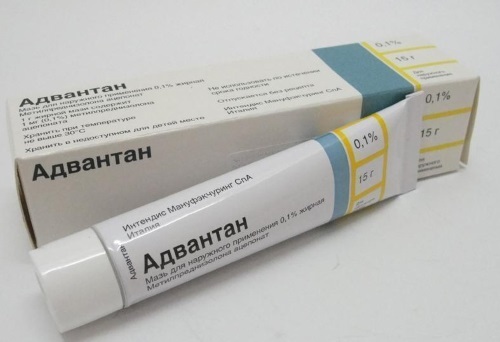
- Comfoderm;
- Akriderm;
- Methylprednisolone aceponate;
- Rederm;
- Celestoderm-B.
The above medicines in the form of ointments and creams are applied to the surface of the skin, which discolored due to lack of melanin, from 1 to 2 times a day, depending on the set mode dosing.
The advantage of this therapy is the simplicity of the treatment process, the rapid relief of local inflammation with the gradual restoration of full-fledged tissue pigmentation. The disadvantage of glucocorticosteroid-based ointments is the risk of side effects, as well as the creation of a drug load on the patient's internal organs.
Phytotherapy
Treatment of vitiligo with herbal medicine involves the use of folk recipes to restore the natural pigmentation of the skin. The table below lists the main effective directions of this therapeutic technique.
| Phytotherapeutic method name | The effectiveness of the treatment |
| Duckweed applications | Marsh duckweed improves the trophism of epithelial tissues, accelerates metabolic processes in the intracellular space, and promotes the natural renewal of melanocytes. Duckweed applications are applied to the surface of depigmented skin once a day for 2 hours. |
| St. John's wort decoction | With the help of a decoction of St. John's wort, wipe the epithelial tissue with signs of vitiligo. The therapeutic efficacy of this agent is to increase the level of T-lymphocytes in the composition of depigmented skin.
|
The advantage of herbal medicine is the safety of this technique, the minimum risk of side effects or acute allergic reactions. The disadvantage of this therapeutic direction is the too slow onset of a positive result. The first effect of herbal medicine is noticeable no earlier than 6 months later. continuous treatment.
Vitamin therapy
The use of vitamin therapy is effective in patients with signs of vitiligo who have weakened immune system, have suffered severe intoxication of the body or prolonged infectious inflammation of epithelial fabrics.
The patient is prescribed an injection of the following substances:
- thiamine bromide;
- a nicotinic acid;
- pyridoxine;
- vitamin A;
- cocarboxylase hydrochloride;
- ascorbic acid;
- cyanocobalamin.
The above-mentioned vitamin substances are taken orally, and are also injected into the patient's body in the form of injections. To achieve the maximum therapeutic effect, the epithelial tissues located in the circumference of the depigmented focus are chipped.
The benefits of vitamin therapy are to increase local immunity, normalize its functions and quickly regenerate new skin cells. The disadvantage of this method is the risk of developing hypervitaminosis, allergic reactions and various kinds of side effects.
Phototherapy
Vitiligo phototherapy is one of the ways to stimulate cells of depigmented skin areas to synthesize renewed melanocytes. This treatment is carried out using the natural rays of the sun or specialized equipment that generates the full spectrum of daytime ultraviolet radiation.
This method of therapy is considered effective for patients with vitiligo of unknown origin, when there are completely no substantiated versions of the sudden disappearance of melanocytes in a certain area body.
The phototherapy method has the following advantages:
- painlessness;
- the duration of the treatment session is from 5 to 15 minutes;
- natural restoration of renewed melanocytes;
- lack of drug load on the internal organs;
- the possibility of using in the treatment of children of all age categories.
The disadvantage of phototherapy is that this method is not used in the treatment of patients with acute intolerance to sunlight. For example, vitiligo patients with critically low levels of melanocytes on depigmented areas of the skin may experience burns with further blistering. A similar reaction manifests itself even after a short contact with the direct rays of the sun.
UV lamp treatment
This method of treating vitiligo is also known as PUVA therapy. Restoration of normal skin pigmentation is achieved by irradiating discolored areas of the body with narrow-band ultraviolet radiation with a wavelength of no more than 311 nm.
Before the start of a therapeutic session, the patient takes the following photosensitizing substances orally or applies to the surface of epithelial tissues:
- 8-methoxypsoralen;
- Beroxan;
- 5-methoxypsoralen;
- Psoraben;
- Trimethylpeorapene;
- Ammifurin.

The above means improve the body's perception of narrow-band ultraviolet radiation. The advantage of PUVA therapy is its high level of effectiveness. It is enough to undergo 3-5 treatment sessions to restore the pigmentation of the lightened skin. The disadvantage of this technique is the need for internal administration of photosensitizing drugs, which create an additional load on the gastrointestinal tract, liver and kidneys.
Laser therapy
The therapeutic method of laser therapy allows for effective treatment of vitiligo on the principle of stimulating epithelial tissues to form new melanocytes. In this case, the helium-neon laser is especially popular.
This therapy method has the following advantages:
- starts the process of natural skin renewal;
- removes depigmented body spots;
- stimulates cell division of melanocytes;
- does not cause pain;
- after the application of laser therapy, there is no mechanical damage to the skin.
The disadvantage of the laser therapy method lies in its low level of efficiency in those conditions when no measures were taken by the attending staff to eliminate the causes of vitiligo spots. In this case, the stimulation of melanocytes with a laser will be neutralized by the influence of negative factors.
Surgery
Treatment of vitiligo (reviews of those who have recovered indicate the need for early diagnosis of this disease) with the help of a surgical operation is considered counterproductive. The principle of surgical intervention is to transplant artificially cultured melanocytes into depigmented vitiligo foci.
This method of treatment is used only in extreme cases, when all previous methods for the restoration of epithelial tissues have been tested. The advantages of the surgical treatment of vitiligo include the fact that upon completion of the surgical manipulations, the cellular substrate will be directly in the focus of the dermatological disease.
The disadvantages of surgical treatment of vitiligo include the following factors:
- surgical intervention involves the use of anesthesia;
- during the period of postoperative recovery, the development of an infectious and inflammatory process is possible;
- there is no guarantee that the implanted melanocyte cells will not be rejected by the patient's immune system;
- in conditions of preservation of the original causes that caused the loss of melanin, repeated depigmentation of the skin is possible.
Surgical treatment of vitiligo is carried out in an inpatient setting of the surgical department. In the postoperative period of rehabilitation, the patient requires additional intake of anti-inflammatory drugs, as well as medications that suppress the activity of cells of the immune system.
The most effective methods for the treatment of different forms of vitiligo, according to the reviews of the cured
For each form of vitiligo, certain treatment methods are suitable that restore full skin pigmentation in the shortest possible period of time.
Acrofacial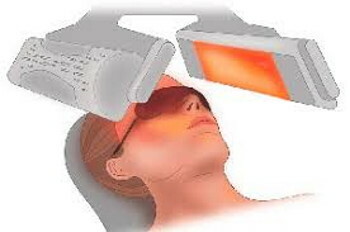
With acrofacial vitiligo, local discoloration of the skin occurs in the distal areas of the hands, the surface of the face and feet of the lower extremities. Treatment of this form of dermatological disease requires the use of the PUVA-therapy method, saturation of the patient's body with vitamin preparations.
Universal
Treatment of universal vitiligo requires the use of systemic therapy methods. In patients with this diagnosis, depigmentation of the entire skin is present.
In this case, it is advisable to use the following therapeutic techniques:
- taking vitamin and immunostimulating agents;
- phototherapy;
- irradiation of the skin with ultraviolet rays;
- surgical transplantation of artificially cultured melanocyte cells.
Patients with the universal form of vitiligo at all stages of treatment should take care of the quality of their diet.
The daily menu includes healthy products of the following types:
- cabbage;
- mutton;
- fresh apples;
- Cod liver;
- corn;
- oatmeal;
- tomatoes;
- rice;
- sea fish.
Therapy of the universal form of vitiligo can be successful only if the factors that provoke skin depigmentation are completely eliminated. Vitamin preparations are taken over a continuous course, the average duration of which is at least 1 month.
Focal (focal)
For the treatment of vitiligo of the focal form of development, it is recommended to use the method of phototherapy, as well as irradiation of depigmented areas of the body with a UV lamp.  A distinctive feature of this dermatological disease is the presence of several spots in one focus of the pathological process.
A distinctive feature of this dermatological disease is the presence of several spots in one focus of the pathological process.
Segmental
Vitiligo of the segmental type is characterized by the presence of irregular volumetric spots, which are located along the line of passage of peripheral nerves. Similar symptoms indicate the neuroendocrine nature of the disease. For the treatment of segmental vitiligo, it is necessary to use the method of vitamin therapy. If there are signs of an inflammatory process, glucocorticosteroid-based ointments are used.
Vitiligo of the mucous membranes
Patients with signs of vitiligo of the mucous membranes of the mouth, anus, penis, vulva are prescribed a course of systemic therapy, which includes vitamins of group B, A, ascorbic acid. Depending on the location of the discolored spots, it is possible to use the phototherapy method.
Dotted vitiligo (confetti spots)
Dotted vitiligo with multiple candy spots is treated with PUVA therapy. Ultraviolet rays are evenly scattered over the entire surface of the body with signs of pinpoint depigmentation. In combination with this method of treatment, laser therapy is used.
Polychrome
Vitiligo of the polychrome type is characterized by hyperpigmentation of certain parts of the skin. On the surface of the human body, spots of different colors can be observed from a milky white to a gray-blue hue. Treatment of a dermatological disease of this type is carried out using vitamin preparations, phototherapy and laser treatment of epithelial tissues.
Inflammatory
Treatment of vitiligo (reviews of those who have been cured indicate that it is quite possible to get rid of this disease) is impossible without preliminary diagnosis of the patient. In case of detection of foci of skin depigmentation with signs of an inflammatory process, ointments and creams based on glucocorticosteroids are prescribed. Medicines of this group are evenly distributed over the entire surface of the skin with signs of hyperemia.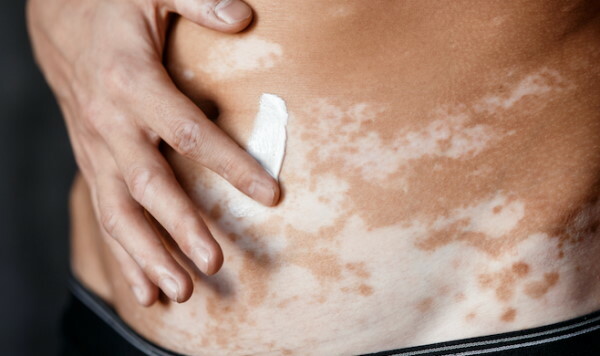
To enhance the therapeutic effect, an injection of glucocorticosteroid solutions is prescribed. These medicines are injected into the skin surface located in the circumference of the depigmented focus. As the inflammatory process fades away, the pathological causes provoking its occurrence are eliminated, a mechanism is launched to restore the normal level of melanocytes.
Perinevus
The halo phenomenon (perineal vitiligo) is a special form of depigmented skin changes. The loss of melanin occurs in the epithelial tissues that are located around the nevus. The occurrence of these symptoms indicates the potential presence of malignant melanoma.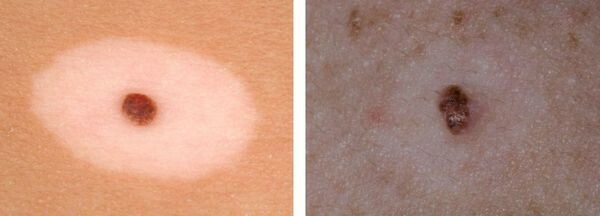
In this case, the treatment process requires the use of chemotherapy drugs, drugs with cytostatic properties. Depigmentation around the nevus is a sign of local destruction of T-lymphocyte cells. Undergoing a course of chemotherapy that destroys cancer cells can restore the normal pigmentation of the affected skin area.
Vitiligo is a chronic condition that must be treated early on. The main symptom of this dermatological pathology is the appearance of milky white or gray spots on the surface of the lower extremities, arms, face, back, abdomen, buttocks, and genitals.
The depigmented areas of the body do not hurt, cause itching or any other discomfort. In rare cases, erythematous inflammation of the borders of discolored tissues is possible. According to the reviews of the cured, it is possible to get rid of vitiligo using the method of ultraviolet irradiation, phototherapy, the use of applications and decoctions from medicinal plants, laser therapy.
Vitiligo treatment video
3 natural remedies for vitiligo:



